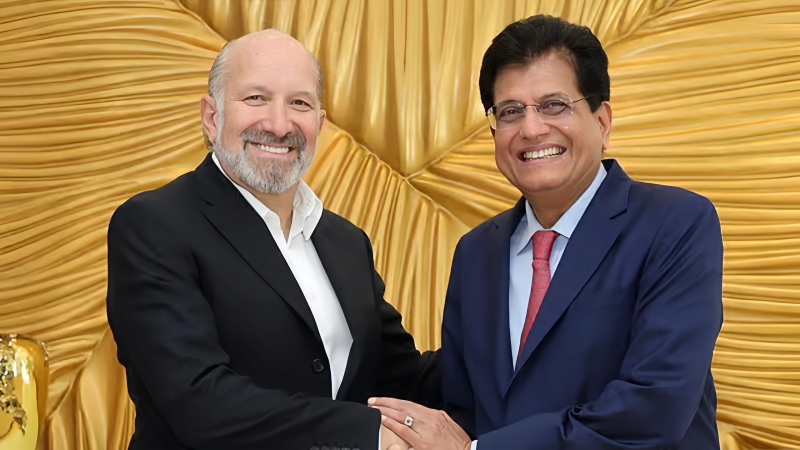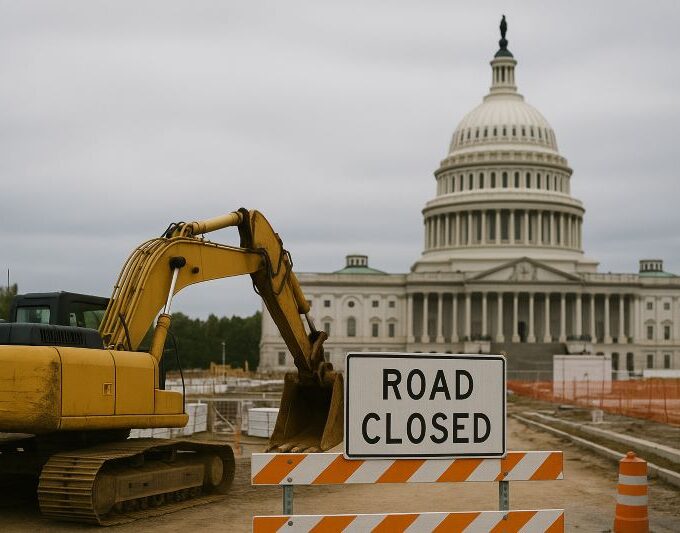Indian Commerce and Industry Minister Piyush Goyal is wrapping up his four-day visit to the United States on May 20 (local time), drawing attention to whether the two countries can reach a consensus on tariff issues. India was among the first countries to begin trade talks with the U.S., and both governments said in April that the negotiations had made significant progress. However, President Trump’s recent claim that “India has proposed zero tariffs on U.S. goods” was publicly refuted by Indian External Affairs Minister S. Jaishankar. How severely could increased U.S. tariffs impact India’s economy? How much leverage does New Delhi really have under Washington’s mounting tariff pressure? And are the so-called “reciprocal tariffs” a threat or an opportunity for India? These questions weigh heavily on India’s final stance.
“$5.76 Billion in Indian Exports to the U.S. at Risk”
Has India offered zero tariffs to the U.S.? According to Al Jazeera on May 18, the United States is India’s largest trading partner. Bilateral trade totaled approximately $129 billion last year, with India enjoying a $45.7 billion surplus. Trump has long complained that India’s tariffs are too high and unfair to U.S. companies, and has proposed a 26% “reciprocal tariff” on Indian goods. Though this tariff has been postponed until July 9, a 10% base tariff still applies to Indian exports, and steel and aluminum products face an additional 25% duty.
According to the Hindustan Times, the U.S. is India’s largest export destination, accounting for 18% of its total exports. Electronics are India’s top export to the U.S., followed by jewelry and pharmaceuticals. Analysts say these sectors are most exposed to the impact of “reciprocal tariffs.” In fiscal year 2023–2024 (April 1, 2023 – March 31, 2024), electronics made up 14% of India’s exports to the U.S., while Indian jewelry made up 30% of U.S. imports in that category. Pharmaceuticals account for 10% of India’s U.S.-bound exports—but notably, Indian pharmaceuticals have been exempted from the “reciprocal tariffs.”
According to the latest report by The Times of India, a study by the Global Trade Research Initiative (GTRI) found that U.S. tariff hikes could reduce India’s exports to the U.S. by $5.76 billion in 2025. The industries most vulnerable to U.S. tariff policy include seafood, steel, gold and diamond jewelry, auto components, and electronics. India’s electronics exports to the U.S. reached $14.4 billion in 2024, accounting for 35.8% of India’s global shipments in this category. U.S. tariff increases could cut these exports by 12%, or $1.78 billion, threatening India’s position as the fourth-largest supplier of electronics to the U.S.
In 2024, the U.S. imported $2 billion worth of frozen fish and shrimp from India, previously exempt from tariffs. If slapped with “reciprocal tariffs,” Indian seafood exports to the U.S. are expected to drop by 20.2%, or $404 million. Similarly, Indian exports of gold jewelry and diamonds could fall by 15.3%, or about $1.82 billion, if such tariffs are imposed. Auto parts, worth $2.8 billion in exports to the U.S. in 2024, could also take a hit. Projections suggest a 12.1% decline, or $339.4 million, due to rising tariff barriers.
However, Mitul Mittal, a portfolio manager at Matthews Asia, told CNBC that sectors like steel are unlikely to suffer much. He argued that exporting steel to India from the U.S. is financially unviable due to high transportation costs.
A report by Emkay Global Financial Services indicates that if the U.S. fully implements “reciprocal tariffs” without triggering broader global reactions, India’s exports to the U.S. could fall by $30 to $33 billion—equivalent to 0.8% to 0.9% of India’s GDP. According to The Economic Times, India’s Finance Minister stated in April that the direct impact on GDP growth would likely range between 0.2 and 0.5 percentage points.
Consumer-Driven Economy Gives India Bargaining Power
President Trump’s complaints about India’s tariffs are not new. During his first term, he called India the “tariff king.” According to Al Jazeera, a report from the Indian Council for Research on International Economic Relations (ICRIER) stated that India’s average tariff rate stands at 17%, compared to 3.3% for the U.S.
Since February, India has made several goodwill gestures toward the U.S. The Hindustan Times reported that India pledged to import $25 billion worth of American energy, eliminated its 6% digital advertising tax, and reduced tariffs on American bourbon whiskey from 150% to 100%. Earlier in May, Bloomberg reported that India also offered to eliminate tariffs on U.S. auto parts within certain limits as part of reciprocal trade talks.
Yet India’s stance appears to be shifting. On May 12, India submitted a notice to the World Trade Organization proposing counter-tariffs on certain U.S.-made goods in response to U.S. duties on Indian steel and aluminum. Qian Feng, a researcher at Tsinghua University’s National Strategy Institute, said that politically, the Modi government risks being seen as weak if it concedes too much. Geopolitically, in light of the broader U.S.-China tariff tensions, India may see a firmer position as better for protecting its economic interests. At the same time, India has intensified regional cooperation with the EU, UK, and ASEAN, signaling economic independence and giving itself room to maneuver in future negotiations.
According to CNBC, India’s consumer-driven economy gives it a significant edge compared to other export-reliant emerging economies in Asia. World Bank data shows that goods and services exports account for just about one-fifth of India’s economy—far lower than Thailand’s 65% and Vietnam’s 87%.
Although U.S. tariffs will target 56.1% of India’s total exports, services—particularly IT services—have so far remained untouched. “We must recognize that the vast majority of Indian exports to the U.S. are IT services,” said James Sullivan, Head of Asia Pacific Equity Research at JPMorgan.
Lin Minwang, deputy director at Fudan University’s Institute of International Studies, noted that India enjoys unique advantages, such as U.S. dependence on Indian pharmaceuticals. Scholar Larsen Gupta from the Indira Gandhi Institute of Development Research told the BBC that India’s relatively low exposure to global goods trade could now work in its favor. Many experts agree, and some media outlets suggest that the U.S.-led global “tariff wars” could actually benefit India by accelerating its emergence as a new global manufacturing hub. According to Gupta, to seize the opportunity, India must remain agile and gradually but strategically open up its trade sectors.
According to the BBC, Arvind Panagariya, an economist at Columbia University, chronicled India’s long-standing protectionist trade policy in his book India’s Trade Policy: The 1990s and Beyond. Between the two World Wars, industries such as textiles and steel in India were heavily shielded by high tariffs. During WWII, chronic shortages of essential goods led India to tighten import controls further, enforced through a complex licensing system.
While other Asian economies like South Korea and Singapore embraced export-led growth in the 1960s—achieving annual GDP growth rates of 8–10%—India doubled down on import substitution. As a result, imports fell from 10% of GDP in 1957–58 to just 4% in 1969–70. By the mid-1960s, India had completely banned consumer goods imports. This not only removed pressure on domestic producers to improve product quality but also cut them off from much-needed capital and technology. Indian products lost competitiveness in global markets, and exports stagnated. This, in turn, caused a chronic foreign exchange shortage, which led to even tighter import controls—creating a vicious cycle of stagnation. Between 1951 and 1981, India’s per capita income grew at a sluggish 1.5% annually.
The turning point came in 1991. Facing a balance of payments crisis, India lifted many import restrictions and devalued the rupee. In 2001, it abolished the consumer goods import licensing regime. The results were dramatic: from 2002 to 2012, India’s goods and services exports soared over fivefold—from $75 billion to more than $400 billion. However, India’s trade liberalization was not without setbacks. According to Panagariya, there were two major reversals: in 1996–97 and again in 2018, when India ramped up its use of anti-dumping measures to curb imports.
The Deccan Herald reports that U.S. tariff hikes may usher in a new wave of trade protectionism in India. While public focus remains fixed on how U.S. “reciprocal tariffs” could affect India’s economy, calls for stronger domestic protection are growing louder. There’s a rising demand for the government to continue its production-linked incentive (PLI) schemes.
According to The Hindustan Times, the U.S. is planning to impose 37% “reciprocal tariffs” on Thailand and 46% on Vietnam. By comparison, the proposed tariffs on Indian goods are relatively moderate. Analysts suggest that India might suffer less than its Southeast Asian peers. In sectors like textiles and apparel, India may even gain a competitive edge as Vietnam’s cost advantage erodes. However, some scholars point out that India has largely neglected the apparel industry, viewing it as a sunset sector, and thus failed to invest effectively. Countries like Malaysia and Indonesia may be better positioned to benefit in this space.
Outlook Unclear for “Three-Phase Trade Deal”
According to Bloomberg (May 20), India hopes to negotiate a three-phase trade agreement with the U.S. Anonymous Indian officials revealed that New Delhi aims to secure a preliminary deal by early July, easing market access for selected U.S. goods. The second phase, slated for September to November, would likely cover 19 key sectors where the two sides reached a broad consensus in April. The third and final phase might not be completed until next year, and would require U.S. Congressional approval.
Negotiations are still ongoing. Bloomberg reports that it remains unclear whether the U.S. will accept India’s phased proposal. According to analyst Qian Feng, the ruling Bharatiya Janata Party (BJP) must strike a delicate balance—protecting domestic industries, safeguarding India’s “strategic autonomy,” and avoiding any political fallout from the talks. Despite its limited leverage, India is unlikely to risk antagonizing the Trump administration and instead favors deepening trade ties with Washington to support its broader economic agenda.
According to the Associated Press, economists have described current U.S. tariff policy as the most extreme since the 1930s. Yale University’s Budget Lab estimates that Trump’s trade policies could raise the U.S. average tariff rate to 17.8%—a level not seen since 1934. When Trump first took office, the average rate stood at just 2.5%. Despite the controversy, tariffs during his first term rose by only one percentage point.
The East Asia Forum, published by the Australian National University, reports that most economists agree: increased U.S. tariffs are likely to heighten global trade uncertainty, risk a worldwide recession, and accelerate the breakdown of the existing international trade order. Small, open economies will be especially vulnerable. However, larger Asian economies and BRICS nations may find new opportunities by adapting to the new landscape. These countries could form alternative trade frameworks, deepen regional integration, and build localized production networks that redefine the future of global commerce.
“In this rapidly evolving environment, regional and multilateral cooperation may prove the most pragmatic strategy for managing growing global uncertainty,” the East Asia Forum wrote. Many countries appear to agree. India recently signed a free trade agreement with the UK. According to India’s LiveMint, the country should now diversify its exports and strike new trade deals with partners such as the UAE. African nations are also moving in this direction. On May 19, Africa Business Insider reported that the Common Market for Eastern and Southern Africa (COMESA), representing 390 million people across 19 member states, is preparing to collectively counter U.S. tariffs. Strengthening intra-regional trade and forming new alliances with the EU, India, and others are among its strategies to reduce dependence on the U.S.













Leave a comment